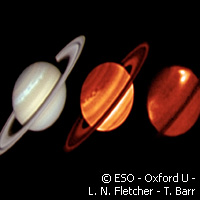Saturn and the swirling, massive storm
Since December 2010, astronomers have been keeping an eye on a massive storm encircling Saturn, the renowned planet with rings that is 10 times bigger than Earth. Saturn, say the experts, has an atmosphere that is relatively calm. But every 30 years or so, the giant planet is impacted by a stirring so deep that it triggers much disturbance. Researchers at the European Southern Observatory (ESO) and NASA have measured the storm's effects clocking in at 600 kilometres (km) into the stratosphere. The findings are published in the journal Science. The astronomers initially used NASA's Cassini spacecraft to detect the storm five months ago and then the ESO's Very Large Telescope (VLT) array in Chile, together with the 'Composite InfraRed Spectrometer' (CIRS) instrument on Cassini, to reveal in detail the fast-moving northern-hemisphere storm. Thunderstorms on Earth meanwhile do not encircle our planet and they usually never surpass 20 km. It should be noted that amateur astronomers also tracked the storm last December. This is the sixth massive storm to be spotted since 1876, and it is the first ever to be probed in the thermal infrared in order to see the variations of temperature within a Saturnian storm, the astronomers say. It is also the first storm ever to be observed by an orbiting spacecraft. 'This disturbance in the northern hemisphere of Saturn has created a gigantic, violent and complex eruption of bright cloud material, which has spread to encircle the entire planet,' says lead author Leigh Fletcher of the University of Oxford in the United Kingdom. 'Having both the VLT and Cassini investigating this storm at the same time gives us a great chance to put the Cassini observations into context. Previous studies of these storms have only been able to use reflected sunlight, but now, by observing thermal infrared light for the first time, we can reveal hidden regions of the atmosphere and measure the really substantial changes in temperatures and winds associated with this event.' The team speculates that the storm originated deep down in the water clouds, where a phenomenon similar to a thunderstorm helped a huge convective plume emerge. That is, the mass of gas rose up and punched through Saturn's usually placid upper atmosphere. According to the astronomers, these disturbances mix with the circulating winds moving east and west, triggering significant changes in the atmosphere's temperature. 'Our new observations show that the storm had a major effect on the atmosphere, transporting energy and material over great distances, modifying the atmospheric winds - creating meandering jet streams and forming giant vortices - and disrupting Saturn's slow seasonal evolution,' says Glenn Orton of Jet Propulsion Laboratory in the United States, a co-author of the study. Dr Fletcher concludes: 'We were lucky to have an observing run scheduled for early in 2011, which ESO allowed us to bring forward so that we could observe the storm as soon as possible. It was another stroke of luck that Cassini's CIRS instrument could also observe the storm at the same time, so we had imaging from VLT and spectroscopy of Cassini to compare. We are continuing to observe this once-in-a-generation event.'For more information, please visit:ESO:http://www.eso.org/public/NASA:http://www.nasa.gov/Science:http://www.sciencemag.org/
Countries
Chile, United Kingdom, United States



